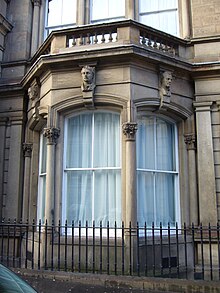 The Society's former museum in Chambers Street, Edinburgh bears sculpted portraits of prominent figures in the field of phrenology. | |
| Formation | 1820 |
|---|---|
| Founders | George Combe and Andrew Combe |
| Dissolved | The last recorded meeting of the Society took place in 1870. The Society's museum closed in 1886. |
The Edinburgh Phrenological Society was founded in 1820 by George Combe, an Edinburgh lawyer, with his physician brother Andrew Combe.[1] The Edinburgh Society was the first and foremost phrenology grouping in Great Britain; more than forty phrenological societies followed in other parts of the British Isles. The Society's influence was greatest over its first two decades and declined in the 1840s; the final meeting was recorded in 1870.[2]
The central concept of phrenology is that the brain is the organ of the mind and that human behaviour can be usefully understood in broadly neuropsychological rather than philosophical or religious terms. Phrenologists discounted supernatural explanations and stressed the modularity of mind. The Edinburgh phrenologists also acted as midwives to evolutionary theory and inspired a renewed interest in psychiatric disorder and its moral treatment. Phrenology claimed to be scientific but is now regarded as a pseudoscience as its formal procedures did not conform to the usual standards of scientific method.[3]
Edinburgh phrenologists included George and Andrew Combe; asylum doctor and reformer William A.F. Browne, father of James Crichton-Browne; Robert Chambers, author of the 1844 proto-Darwinian book Vestiges of the Natural History of Creation; William Ballantyne Hodgson, economist and pioneer of women's education; astronomer John Pringle Nichol; and botanist and evolutionary thinker Hewett Cottrell Watson. Charles Darwin, a medical student in Edinburgh in 1825–7, took part in phrenological discussions at the Plinian Society and returned to Edinburgh in 1838 when formulating his concepts concerning natural selection.[4]
- ^ "The Rise of Phrenology in Edinburgh". phrenology.mvm.ed.ac.uk. Archived from the original on 4 March 2016. Retrieved 23 September 2016.
- ^ "Records of the Phrenological Society of Edinburgh – Archives Hub". archiveshub.jisc.ac.uk. Retrieved 23 May 2019.
- ^ "The Fall of Phrenology in Edinburgh". Anatomical Museum. School of Biomedical Sciences, University of Edinburgh. Archived from the original on 2 April 2015.
- ^ "The History of Phrenology: A Chronology". victorianweb.org. Retrieved 20 January 2017.
